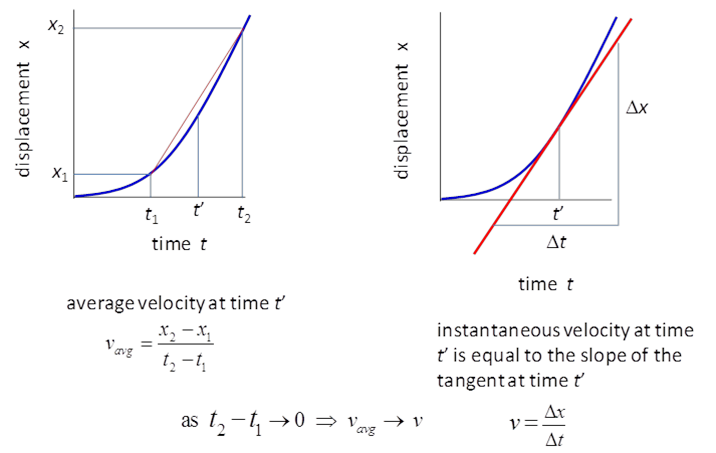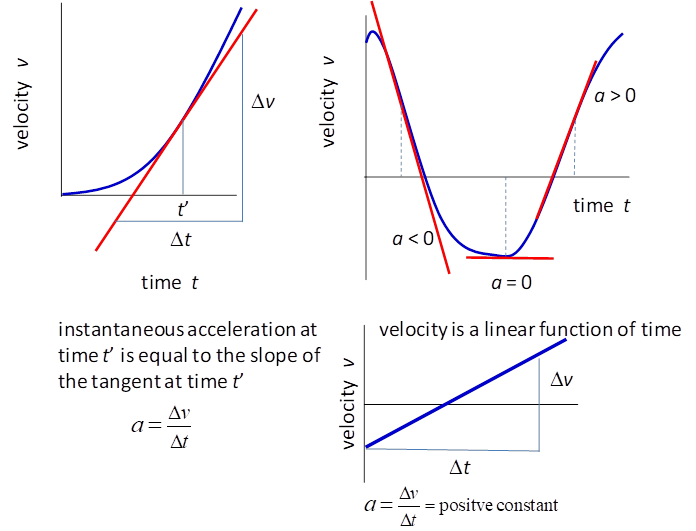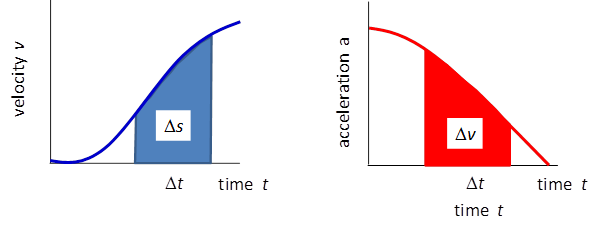|
RECTILINEAR MOTION: DISPLACEMENT VELOCITY ACCELERATION
Ian Cooper email matlabvisualphysics@gmail.com DISTANCE AND DISPLACEMENT In
this document on kinematics will we only consider the motion of objects in one-dimension.
This is called rectilinear motion. Previously, we looked at the motion
of a particle in a plane [2D] where the motion was expressed in terms of the
components directed along the Cartesian coordinate axes. One advantage of
studying [1D] motion is that we don’t have to use vector notation for displacement,
velocity and acceleration even though they are vectors. You can’t
associate a positive or negative sign with a vector quantity, however, the
components of the vector are negative or zero or positive. Consider the displacement vectors shown
in figure (1).
Fig. 1.
A vector can’t be a positive or negative number but its components
can be negative or zero or positive.
To
describe the motion of a moving object you must first define a frame of
reference (Origin and X axis) and the object is represented as a point particle.
Consider
the tram moving backward and forwards along a straight 2.00 km track. The X axis
is taken along the track with the Origin at x = 0. The left end of the track is at x = -1.00 km and the right end of the track is at x = +1.00 km. The tram start at time
Fig. 2. A
frame of reference for the rectilinear motion of the tram with the Origin at x = 0. The trams travels from the left to the
right end and travels back to the left end of the track. Event
#1: At time Event
#2: At time The time interval
N.B. Time and time interval are different physical
quantities. The
distance
travelled
The
magnitude of the displacement
Distance travelled
(scalar) is not the same physical quantity as displacement (vector) SPEED AND VELOCITY Speed
and velocity refer to how fast something is travelling but are different
physical quantities. Also, we need to distinguish between average and
instantaneous quantities. The
average
speed (1)
The average speed is a positive scalar quantity and not
a vector. The
average
velocity (2)
For one-dimensional motion directed along the X axis
we do not need the use the vector notation shown by the arrow above the
symbol. In
the example of our tram:
average
speed
average
velocity N.B. very different values for the average speed and average
velocity. Often the same symbol is used for speed and velocity. You always
need to state whether the symbol represents the speed or velocity. Our
tram speeds up continually until it reaches the Origin, it then slows down
and stops at the right end of the track. In the return journey, it
continually speeds up until it reaches the Origin it then slows down and
stops at the left end of the track. The speed and velocity are always
changing. Hence, it is more useful to talk around instantaneous values rather than average values. The
instantaneous velocity The
average velocity given by equation (3) is (3) If
we make the time interval This
limit is one way of defining the derivative of a function. The instantaneous
velocity is the time rate of
change of the displacement (4) For
rectilinear motion along the X axis, we don’t need the vector notation
and we can simply write the instantaneous velocity as (5) You
don’t need to know how to different a function, but you have to be
familiar with the notation for differentiation and be able to interpret the
process of differentiation
as finding the slope of the tangent to
the displacement vs time graph at one instant of
time as shown in figure (3).
Fig. 3. The
average and instantaneous velocities can be found from a displacement vs time graph. The slope of the tangent gives the
instantaneous velocity (derivative of a function). As the time interval approaches
zero When
you refer to the speed or velocity it means you are talking about the
instantaneous values. Therefore, on most occasions you can omit the word
instantaneous, but you can’t omit the term average
when talking about average
speed or average
velocity. ACCELERATION Velocity is related to how fast an object is travelling. Acceleration
refers to changes in velocity. Since velocity is a vector
quantity, an acceleration occurs when · an object speeds up (magnitude of velocity increases) · an object slows down (magnitude of velocity decreases) · an object changes direction (direction of velocity changes) Acceleration is a vector quantity. You don’t sense how
fast you are travelling in a car, but you do notice changes in speed and
direction of the car especially if the changes occur rapidly – you
“feel” the effects of the acceleration. Some of the effects of
acceleration we are familiar with include: the experience of sinking into the
seat as a plane accelerates down the runway, the "flutter" in our
stomach when a lift suddenly speeds up or slows down and “being thrown
side-ways” in a car going around a corner too quickly. The average acceleration
of an object is defined in terms of the change in velocity and the
interval for the change (6) The instantaneous
acceleration (acceleration)
is the time rate of change of the velocity, i.e., the derivative of the
velocity gives the acceleration (equation 6). Again, you don’t need to
differentiate a function but you need to know the notation and interpret it
graphically as the acceleration is the slope of the tangent to a velocity vs time graph as shown in figure (4). The area under the
acceleration vs time graph in the time interval is
equal to the change in velocity in that time interval as shown in figure (5). (7) (8)
Fig. 4.
Velocity vs time graphs for rectilinear
motion. The slope of the tangent is equal to the acceleration. For the
special case when the velocity is a linear function of time (straight line)
the acceleration is constant. The reverse process to differentiation is integration. Graphically,
integration is a process of finding the area under a curve. The slope of the tangent to the displacement vs
time graph is equal to the velocity. The area under a velocity vs time
graph in a time interval The area under a
acceleration vs time graph in a time interval
Fig. 5. The
area under the velocity vs time graph in the time
interval |



















